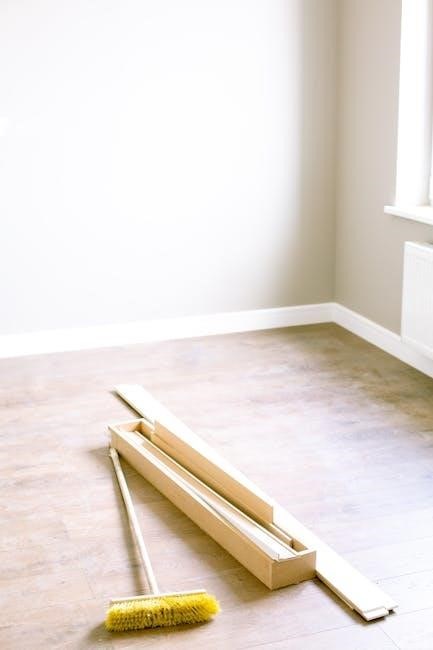Welcome to Harper and Bright Designs Assembly Instructions. This guide provides a comprehensive walkthrough for assembling various models, ensuring safety and ease. Follow step-by-step directions for successful completion.
Overview of Harper and Bright Designs
Harper and Bright Designs is a reputable brand known for creating high-quality, multifunctional furniture, particularly beds, that combine style and functionality. Their products, such as the Twin Size Low Loft Bed and Full Bunk Bed with Stairs, are designed to meet diverse needs, offering space-saving solutions and aesthetic appeal. The brand emphasizes durability and ease of assembly, providing clear instructions for a seamless experience. Whether for children or adults, Harper and Bright Designs prioritizes comfort, safety, and innovative design, making them a popular choice for modern households seeking practical yet stylish furniture options.
Importance of Following Assembly Instructions
Following Harper and Bright Designs assembly instructions is crucial for ensuring the safety, durability, and proper functionality of your furniture. Incorrect assembly can lead to structural issues, instability, and potential hazards, especially for beds and loft systems. Adhering to the provided guidelines helps prevent damage to components, avoids costly repairs, and ensures all safety features are intact. Clear instructions also save time and reduce frustration, guiding you through each step methodically. By following the manual, you guarantee a sturdy and long-lasting product that meets its intended purpose, providing peace of mind and optimal performance for years to come.
Preparation Before Assembly
Before starting assembly, ensure all components and hardware are accounted for by cross-referencing with the provided parts list. Clear a spacious, flat workspace and cover it with a protective cloth to prevent damage. Unpack all items carefully, checking for any loose or damaged parts. Gather the required tools and organize them for easy access. Read through the entire manual to understand the assembly process and identify any specific sequences or precautions. This preparation ensures a smooth and efficient assembly experience, minimizing delays and potential errors. Proper planning and organization are key to achieving a successful outcome.

Safety Tips and Precautions
Always wear safety gloves and eyewear to protect yourself during assembly. Ensure the workspace is clear of clutter and tripping hazards. Use tools responsibly and avoid over-tightening parts to prevent damage or instability.
General Safety Guidelines
Adhere to safety guidelines to avoid injuries and ensure a secure assembly process. Always wear protective gloves and eyewear. Clear the workspace of clutter and tripping hazards. Inspect all parts for damage before use. Follow weight limits and avoid overloading furniture. Keep children and pets away during assembly. Use power tools with caution and maintain a firm grip. Avoid wearing loose clothing that could get caught in tools. Ensure proper ventilation when using chemicals or adhesives. Regularly tighten loose bolts to maintain stability. Follow diagrams and manufacturer instructions closely. If unsure, consult additional resources or seek assistance from a qualified individual.
Tools and Equipment Required
Ensure you have the necessary tools and equipment before starting assembly. Essential tools include an Allen wrench (provided in the hardware package), a screwdriver (both Phillips and flathead), and pliers for gripping small parts. A rubber mallet may be useful for tapping pieces into place without causing damage. Optional tools include a power drill for faster screw driving. Always check the parts list and hardware package to confirm all components are included. Organize components by categories to streamline the process. Use a workbench or sturdy table for stability. Refer to the instructions for specific tools required for your model, as some may vary.
Workspace Preparation
Proper workspace preparation is crucial for a smooth assembly process. Choose a flat, stable, and spacious area to accommodate all components and tools. Cover the floor or surface with a protective cloth or cardboard to prevent damage. Clear the workspace of any obstructions to ensure easy access and movement. Position the parts and tools within easy reach to minimize delays. Ensure adequate lighting to read instructions and view small components clearly. A clean and organized workspace helps reduce errors and enhances efficiency. Always refer to the instructions for specific space requirements based on the model you are assembling.
Gathering Tools and Parts
- Gather all necessary tools and parts before starting.
- Essential tools include an Allen wrench, screwdrivers, and a measuring tape.
- Check the parts list to ensure all components are included.
- Organize components to save time during assembly.
Tools Needed for Assembly
To ensure a smooth assembly process, gather the necessary tools beforehand. Essential items include an Allen wrench, Phillips-head screwdriver, and a measuring tape. Additionally, a rubber mallet may be useful for tapping parts into place. Ensure all tools are in good condition to avoid stripped screws or damaged components. Refer to the provided parts list to identify any specialized tools required for your specific model. Organize tools in a accessible location to streamline the process. Double-check the packaging for any small hardware items that may have been included separately. Proper preparation will save time and reduce frustration during assembly.
Understanding the Parts List
The parts list is a detailed catalog of all components included in your Harper and Bright Designs kit. It helps identify each item, ensuring no parts are missing or damaged. Typically, the list is categorized by size, shape, and function, making it easier to organize components before assembly. Cross-referencing the list with the provided diagrams ensures clarity. Pay special attention to hardware like screws, bolts, and Allen wrenches, as these are crucial for securing joints. Verify the completeness of the parts before starting assembly to avoid delays. This step is essential for a smooth and efficient assembly process.
Organizing Components Before Assembly

Organizing components before assembly is crucial for a smooth process. Start by unpacking and sorting all parts into categories, such as hardware, frames, and accessories. Use the provided diagrams or labels to identify each item. Group similar pieces together, like screws, bolts, or slats, and store them in separate containers. This prevents losing small parts and saves time during assembly. Refer to the parts list to ensure all items are accounted for. Lay out larger components, such as headboards or side rails, in a logical order based on the instructions. Proper organization ensures efficiency and reduces the risk of errors during assembly.
Step-by-Step Assembly Guide

Harper and Bright Designs provides a detailed, model-specific assembly guide. Follow clear instructions and diagrams for bed frames, headboards, and storage units to ensure safety and efficiency.
Assembling the Bed Frame
Begin by unpacking all components and laying out the bed frame parts. Use the provided Allen wrench to attach side rails to the headboard and footboard. Ensure all bolts are tightened securely. Next, place the support slats evenly across the frame, aligning pre-drilled holes with the side rails. Use the screws from the hardware kit to secure the slats firmly. Double-check the frame’s stability by gently rocking it. If any wobbling occurs, tighten the bolts. Refer to the diagrams for precise alignment and part identification. Always use the tools recommended in the instructions for a safe and accurate assembly process.
Attaching the Headboard
To attach the headboard, align its mounting brackets with the pre-drilled holes on the bed frame’s side rails. Insert the provided screws and gently tighten them using a screwdriver or Allen wrench. Avoid overtightening initially; instead, secure the headboard in place and check its alignment. If necessary, adjust the headboard for proper positioning and ensure it is level with the top of the frame. Once aligned, tighten all screws firmly. Use a rubber mallet to tap the headboard into place gently, ensuring it is securely seated without damaging the finish. Double-check the headboard’s stability before proceeding to the next assembly steps.
Installing Side Rails
Begin by unpacking the side rails and ensuring all hardware is included. Align the side rails with the pre-drilled holes on the bed frame’s base. Secure the rails using the provided bolts or screws, tightening them firmly with a screwdriver or wrench. Ensure the rails are evenly spaced and properly aligned for stability. Use a level to confirm the rails are straight. Tighten all connections securely but avoid overtightening, which may damage the material. Double-check the rails’ positioning to ensure they fit snugly against the frame. Once installed, proceed to attach the slats or support systems as outlined in the instructions.
Securing Slats and Support Systems
After installing the side rails, place the slats evenly across the bed frame. Align each slat with the pre-drilled holes on the rails, ensuring proper spacing for support. Secure the slats using the provided screws or bolts, tightening them firmly. For added stability, attach the center support system if included, following the manufacturer’s instructions. Ensure all connections are tight and check for any wobbling. Use a level to confirm the slats are evenly aligned. Once all slats and supports are in place, test the bed’s stability by gently applying pressure. Properly secured slats and supports are essential for the bed’s durability and safety.
Adding Drawers or Storage Units
Position the drawer or storage unit under the bed frame, aligning it with the pre-drilled holes. Attach the drawer slides to the bed frame and the drawer itself, following the manufacturer’s instructions. Secure the slides using the provided screws, ensuring they are tightly fastened. Once installed, test the drawer by pulling it out to ensure smooth operation. Adjust the slides if necessary for proper alignment. Repeat for additional drawers or storage units. Ensure all drawers are level and securely attached before use. Proper installation ensures optimal functionality and stability of the storage compartments.
Finalizing the Bed Assembly
After completing the bed frame, headboard, and side rails, ensure all connections are secure and properly aligned. Tighten any loose screws or bolts for stability. Verify that the slats and support systems are firmly attached. If drawers or storage units are included, check their smooth operation by sliding them in and out. Ensure the bed is level by adjusting the legs or using shims if necessary. Test the bed’s stability by gently rocking it or applying weight to confirm it doesn’t wobble or creak. Conduct a final inspection to ensure all parts are correctly aligned, with no sharp edges or protruding hardware. Ensure all provided screws and bolts are used, and no components are left over. Once everything is confirmed to be secure and functional, the bed is ready for use.

Specific Assembly Instructions for Different Models
Harper and Bright Designs offers tailored instructions for various models, including Twin Size Low Loft Bed, Full Bunk Bed with Stairs, and Daybed. Each model has unique assembly steps, ensuring proper construction and functionality. Follow the specific guide for your model to achieve a sturdy and safe final product, adhering to the provided diagrams and instructions carefully. This ensures all parts fit seamlessly, resulting in a durable and aesthetically pleasing piece of furniture tailored to your needs. Proper assembly guarantees optimal performance and longevity of your Harper and Bright Designs product.
Assembly of Twin Size Low Loft Bed
The assembly of the Twin Size Low Loft Bed begins with unpacking and organizing all components. Start by attaching the headboard to the bed frame using the provided bolts and screws. Next, install the side rails, ensuring they are securely fastened. Place the slats evenly across the frame for support. Attach the ladder to the designated side, making sure it is stable. Finally, tighten all connections and test the bed for stability. Refer to the included diagrams for precise alignment. This model is designed for easy assembly, requiring basic tools like a Phillips-head screwdriver. Two people are recommended for safe and efficient assembly. Always double-check all connections to ensure the bed is sturdy and safe for use.
Instructions for Full Bunk Bed with Stairs
Assembling the Full Bunk Bed with Stairs begins with the lower frame. Attach the side rails and slats, ensuring a sturdy base. Next, assemble the upper bunk by securing the headboard and side rails. Carefully place the upper frame onto the lower section, aligning the pre-drilled holes. Install the stairs by attaching them to the designated side of the lower frame. Use the provided bolts and screws for all connections. Tighten all joints firmly to ensure stability. Double-check the alignment of the stairs and upper bunk for safety. Refer to the diagrams for precise placement of each component. This model requires two people for safe assembly, and all tools needed are included in the package. Once complete, test the bed for stability before use.
Guidelines for Daybed Assembly
Begin by carefully unboxing and inventorying all parts and hardware. Start with the daybed frame, attaching the side rails to the headboard and footboard using the provided bolts. Secure the slats to the frame, ensuring even spacing for optimal support. Next, attach the backrest panels to the frame, aligning the pre-drilled holes. Place the cushions and bedding according to the manufacturer’s recommendations. Double-check all connections for tightness and stability. If the daybed includes storage drawers, assemble them separately and attach them to the frame as instructed. Finally, inspect the assembly for any gaps or loose joints and test the bed for stability before use.
Troubleshooting Common Issues
Identify missing or damaged parts early and double-check packaging. Address alignment problems by ensuring components fit correctly. Tighten loose joints and refer to the manual for solutions.
Identifying Missing or Damaged Parts
Begin by carefully checking all packaging materials for small parts that may have loosened during shipment. Cross-reference each item with the provided parts list to ensure everything is included. Inspect components for visible damage, such as dents or scratches, which could affect assembly. If a part is missing or damaged, contact customer support immediately for a replacement. Organize components as you unpack them to avoid misplacement. Addressing these issues early prevents delays and ensures a smooth assembly process. Always refer to the manual for guidance on identifying and handling missing or damaged parts effectively.

Resolving Alignment Problems
If components do not align properly during assembly, recheck the instructions to ensure correct part placement. Verify that all bolts and screws are loosened as specified before tightening. Use a rubber mallet to gently tap parts into place if they are stubborn. Misalignment often occurs due to incorrect sequencing or overlooked steps. Double-check the orientation of slats, rails, and supports. If issues persist, consult the troubleshooting section or contact customer support for clarification. Avoid forcing parts into position, as this may cause damage. Proper alignment is crucial for stability and safety, so address any discrepancies before proceeding further in the assembly process.
Fixing Loose Joints or Connections
Tighten all bolts and screws firmly but avoid overtightening, which can damage the material. Use an Allen wrench or screwdriver as specified in the instructions. If joints remain loose, check for any gaps or misaligned parts. Ensure all washers and spacers are correctly placed. Apply a small amount of wood glue to joints if necessary. For metal connections, verify that brackets or clips are securely fastened. If looseness persists, consider using locking nuts or tightening in short intervals. Properly securing all joints is essential for the stability and longevity of the assembled furniture, ensuring safety and preventing structural issues over time.

Additional Tips for Successful Assembly
Work in a well-lit, spacious area and use power tools wisely. Follow diagrams closely and double-check instructions to avoid mistakes. Taking your time ensures a sturdy result.
Working with a Partner
Working with a partner can significantly simplify and speed up the assembly process. Divide tasks based on your strengths and communicate clearly to avoid confusion. One person can focus on reading instructions while the other handles the tools and parts. Teamwork ensures that heavy components are lifted safely, reducing the risk of injury or damage. Additionally, having a second pair of hands can help with aligning parts correctly and tightening bolts securely. This collaborative approach not only makes assembly more efficient but also enhances the overall experience, making it less stressful and more enjoyable.
Using Power Tools Effectively
Using power tools effectively is crucial for a smooth assembly process. Always choose the right tool for the task, such as a drill or screwdriver, to ensure accuracy and efficiency. Keep your tools well-maintained and charged to avoid interruptions. Wear safety goggles to protect yourself from debris. Use the correct screwdriver bits to prevent stripping screws. Apply steady, controlled pressure to avoid damaging parts. Follow the manufacturer’s guidelines for tool usage and speed settings. Proper use of power tools not only speeds up assembly but also ensures a professional finish and prevents potential damage to the components.
Following Diagrams and Instructions Closely
Following diagrams and instructions closely is essential for successful assembly. Carefully review each step to understand the process before starting. Use the provided diagrams to identify parts and their correct placement. Double-check measurements and alignments to avoid errors. Pay attention to symbols and notes, as they often highlight critical steps. If unsure, refer back to the instructions or consult online resources for clarification. Patience and attention to detail ensure a proper assembly, preventing mistakes and saving time. Always verify each step before moving forward to guarantee accuracy and safety in the assembly process.

Final Checks and Quality Assurance
After assembly, inspect the finished product for stability and durability. Ensure all parts are securely fastened and aligned properly. Test the bed’s weight capacity and overall structure. Make any necessary adjustments for a polished finish.
Inspecting the Finished Product
After completing the assembly, carefully inspect the finished product for any defects or misalignments. Ensure all parts are securely attached and properly fitted. Check the bed’s legs, slats, and support systems for stability and evenness. Verify that all bolts and screws are tightened firmly. Test the bed’s stability by gently applying pressure to ensure it does not wobble or creak. Inspect the surfaces for scratches or damage. If everything meets your expectations, the bed is ready for use. This final inspection ensures safety and durability, guaranteeing a well-assembled and reliable piece of furniture.
Testing Stability and Durability
Once assembled, test the bed’s stability by gently rocking it from side to side and applying moderate pressure to ensure it does not wobble. Check for any creaking sounds, which may indicate loose joints. Ensure all slats and support systems are evenly distributed and securely attached. Apply weight gradually to assess durability, starting with light pressure and increasing to simulate normal use. Test any drawers or storage units for smooth operation. Verify that all moving parts function effortlessly without jamming. This step ensures the bed is sturdy, reliable, and safe for long-term use, meeting Harper and Bright Designs’ quality standards.
Making Final Adjustments
After completing the assembly, ensure all parts are tightly secured and properly aligned. Tighten any loose screws or bolts for added stability. Check if the bed sits level on the floor and make adjustments if necessary. Ensure drawers or storage units align correctly and open smoothly. Verify that all moving parts function without obstruction. If any components seem misaligned, refer to the instructions for guidance. Finally, conduct a thorough inspection to ensure no steps were overlooked. Making these final adjustments guarantees a safe, functional, and visually appealing product that meets Harper and Bright Designs’ quality expectations.

Maintenance and Care
Regularly clean surfaces with a soft cloth and mild detergent. Inspect bolts and screws to ensure they remain tight. Store assembly instructions securely for future reference.
Cleaning and Upkeep
Regular cleaning is essential to maintain the quality and appearance of your Harper and Bright Designs furniture. Use a soft, dry cloth to wipe down surfaces, removing dust and dirt. For tougher stains, dampen the cloth with mild detergent, but avoid harsh chemicals or abrasive cleaners that may damage finishes. Always test a small, inconspicuous area first. Avoid exposing the furniture to excessive moisture, as it can harm the materials. For upholstery, vacuum gently and spot clean spills immediately with a clean, damp cloth; Regular upkeep ensures longevity and preserves the aesthetic appeal of your assembled pieces.
Regular Inspection of Bolts and Screws
Regularly inspect bolts and screws to ensure all connections remain secure and tight. Over time, vibrations or daily use may cause loosening, which can affect stability. Use an Allen wrench or screwdriver to tighten any loose fasteners. Check for signs of wear, rust, or damage, and replace damaged hardware immediately. Inspect all joints and hinges, as these are common points of stress. Maintain a routine inspection schedule, especially for frequently used furniture, to prevent structural issues. Keeping bolts and screws in good condition ensures the durability and safety of your Harper and Bright Designs assembly.
Storing Assembly Instructions for Future Reference
Store assembly instructions in a safe, accessible location to ensure they remain available for future use. Organize manuals in a designated folder or binder, labeling them clearly for easy identification. For digital copies, save them in a secure cloud storage service or on a personal device. Regularly back up files to prevent loss due to device failure. Consider printing a physical copy for quick reference. Storing instructions properly helps maintain organization and ensures they are readily available for repairs, adjustments, or disassembling furniture. This proactive approach saves time and reduces stress when future maintenance or reassembly is needed.
Harper and Bright Designs assembly instructions ensure successful completion of your furniture project. Follow the guidelines for a durable, stylish, and functional result. Happy assembling!
Begin by carefully unpacking and organizing all components. Use the provided tools to assemble the bed frame, ensuring all bolts and screws are securely tightened. Attach the headboard and side rails, followed by slats and support systems for stability. If applicable, install drawers or storage units according to the manual. Double-check alignment and tighten any loose connections. Refer to diagrams for clarity and follow step-by-step instructions to avoid errors. Finally, inspect the finished product for stability and durability, making any necessary adjustments. Patience and precision are key to a successful assembly process.

Importance of Patience and Precision
Patience and precision are crucial when assembling Harper and Bright Designs furniture. Rushing through steps can lead to errors, misalignment, or loose connections, compromising the product’s stability and safety. Take time to carefully follow instructions, ensuring each part is correctly fitted. Double-checking bolts and screws prevents future issues. Working methodically reduces frustration and ensures a durable, long-lasting result. Assembly requires attention to detail, so avoid distractions and maintain focus throughout the process. By prioritizing patience and precision, you achieve a professional-quality finish and enjoy the full functionality of your Harper and Bright Designs furniture.
Final Thoughts on Harper and Bright Designs Assembly
Assembling Harper and Bright Designs furniture can be a rewarding experience, yielding a durable and functional piece for your home. With clear instructions and proper preparation, you’ll achieve professional-quality results. Remember, patience and attention to detail are key to ensuring stability and longevity. The finished product not only enhances your space but also reflects your dedication to quality craftsmanship. Always refer to the provided manuals for guidance, and don’t hesitate to seek support if needed. By following these steps, you’ll enjoy your Harper and Bright Designs furniture for years to come, knowing it was assembled with care and precision.
